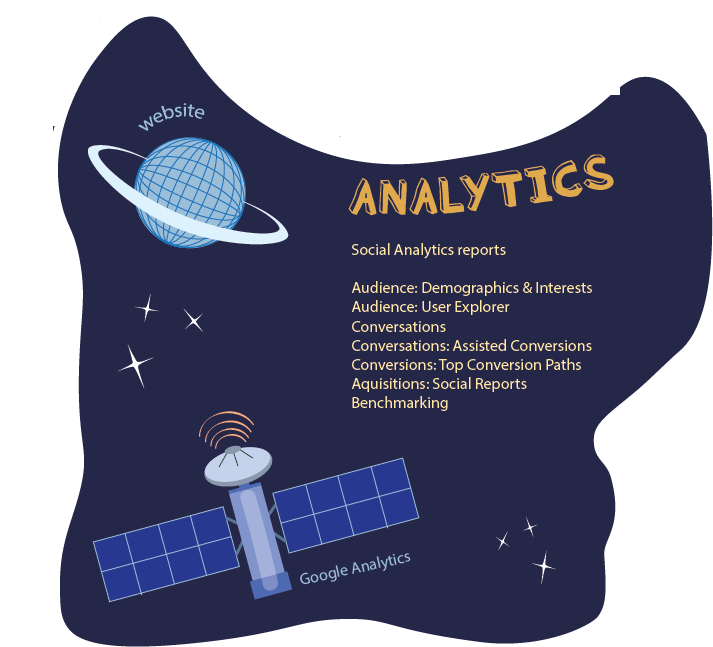
By understanding messages and channels in a way you have come full circle in developing your communication strategy – your communication tree.
However as in nature nothing is still in order for your tree to grow you need to continue taking care of and understanding the forces that are influencing it. Symbolically we have titled this piece “weather prognosis” and it relates to using tools to assess how successful you have been in achieving your communication goals in order to be able to adapt your approach or set a new goal if the current is being met.
Unfortunately a large number of brands are unable to effectively measure the impact of their social media marketing efforts.
In fact, the CMO survey 2018 claimed only 23.3% of marketers are able to prove the impact of social media marketing quantitatively.
So the question is, how do marketers measure the impact of their social media marketing strategies? And is it possible to do so without spending an arm and a leg on expensive marketing tools and resources?
Well, Google Analytics can help.
With relevant quantitative data, Google Analytics easily helps you identify which social media platforms drive the maximum, targeted traffic to your site. Also, it’s possible to find out how these social media users interact with your website.
In addition, setting up a Google Analytics dashboard to monitor and analyze your social media efforts helps you determine your social media ROI.
Although this is a topic that would require a separate in depth course here we will cover the basics just to convey some essentials and you should continue to educate yourself on these tools as best fitting to your particular line of work.
So let’s check out 7 types of social analytics reports that will help you understand how impactful your social media marketing efforts are:
1. Audience: Demographics & Interests
The major objective of any social media campaign is to reach out to the right set of audiences.
This is where Google Analytics “Demographics and Interests” report comes to your rescue.
It allows you to analyze the demographic and interest information of incoming visitors to your website. This can help you understand if your social media marketing strategies are effective enough to pull the right type of audiences.
In order to do this, you’ll need to filter the social media traffic from the overall traffic segment. Once you filter the traffic, this report will help you figure out if your social media targeting is effective enough to drive the desired traffic. It will provide you with insights to help you expand your audiences.
2. Audience: User Explorer
Next you need to check if people are taking the desired action after they are directed from social media sites. To do so, you’ll need to analyze the journey of the user. The “User Explorer” report will help you understand what social sites are driving return visitors to your site. And how those visitors navigate through your site, and when these repeat visitors return.

3. Conversions
This is yet another report that lets you understand the impact and effectiveness of your social media marketing strategies. Conversions could be lead form submissions, sales, email subscriptions, unique page views or sessions.
It is important to avoid taking the “last click” approach into consideration. Because social media usually drives early visits in the buyer journey, even when it isn’t the last click source leading to conversions.
4. Conversions: Assisted Conversions
The not-so-popular “Assisted Conversions” report gives you a complete picture of the impact of different channel sources leading to the final conversion. “Assisted Conversions” are attributed to the multiple user sessions prior to conversions.
This report helps you identify the different channels that are pushing a user to enter your site before converting into an actual buying customer.

5. Conversions: Top Conversion Paths
This report lets you understand the path that your users take before they convert. This means the report helps identify all of the social media sites that are driving visits to your website.
It will also show you the frequency of conversions from each path. Basically, this report will help you understand how well your social media marketing is working for you in terms of pushing people down your funnel.

6. Acquisition: Social Reports
This Google Analytics report focuses exclusively on social media. This report offers exhaustive insights into social traffic to help you understand the impact of the social media segment.
This report offers:
- Overview of social traffic
- Overview of specific social media sites driving traffic
- Landing pages for social traffic
- Conversions attributed to particular social media sites
- Content engagement and user flow report
These reports can offer exhaustive insights into whether the social traffic is helping you realize your goals or not.

7. Benchmarking
As the name suggests, the “Benchmarking” report offers insights into your traffic and compares it against your competitors in the industry. Filter the report further to see the benchmark in different industries and segments. This report points you in the right direction and helps you improve your social media marketing strategy.

Useful links:
If you want to know more about Facebook analytics here are some additional resources:
▶ A Beginner’s Guide to Facebook Analytics
https://blog.hootsuite.com/facebook-analytics-insights-beginners-guide/
▶ How To Use Facebook Analytics Tool to Grow Your Business
https://adespresso.com/blog/facebook-analytics/
▶ The Ultimate Guide to Facebook Analytics
https://www.disruptiveadvertising.com/analytics/facebook-analytics/
As mentioned, this is just the tip of the ice berg in the area of analytics and it serves to get you thinking on how you can adapt it to your communication and conversion needs.
There are many available free online resources that you can use to find out more about this topic and I urge you to consider them as they are necessary for your communication eco system to thrive and keep growing.
